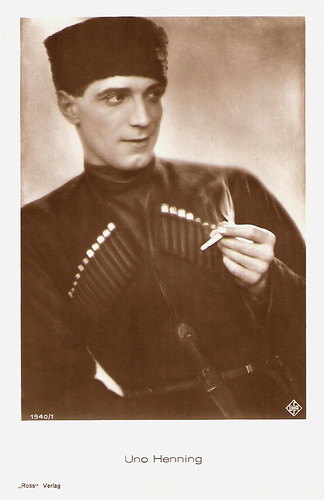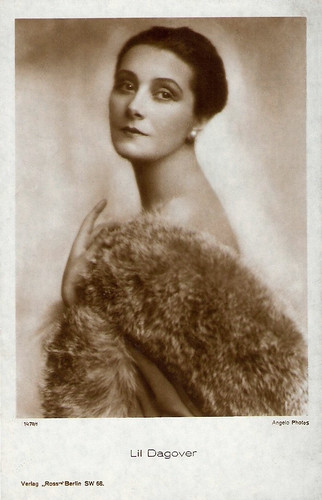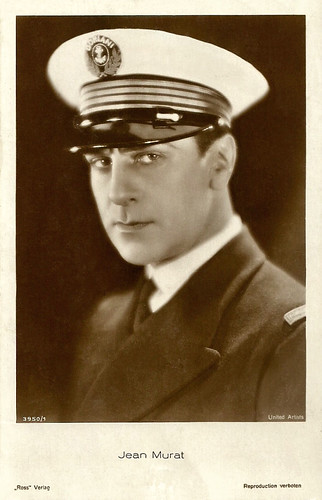Swedish actor Uno Henning (1895-1970) appeared from 1919 in some 40 film and TV productions in Sweden, Germany and Great Britain.

Swedish postcard by Lunggrens Konstförlag, Stockholm, no. 219. Photo: Atelier Gösta Hard.

German postcard by Ross Verlag, no. 1940/1, 1927-1928. Photo: UFA. Publicity still for Die Liebe der Jeanne Ney/The Love of Jeanne Ney (1927).
Knut Uno Henning was born in Stockholm, Sweden in 1895. He was the son of Karl Bernard Henning and Eleonora Henning-Martin.
From 1915 to 1917, he studied at Dramatens Elevskola, the Royal Dramatic Theatre's acting school, and in 1918 he was engaged at Dramaten (the Royal Dramatic Theatre). He worked there till 1925 and later again from 1935 to 1965. Here he starred in plays by August Strindberg, Jean-Paul Sartre and Eugene O’Neill.
The handsome, blonde actor made his film debut in Rune Carlsten’s comedy Ett farligt frieri/A Dangerous Courtship (1919) starring Lars Hanson. He played another supporting part in Bodakungen/Tyranny of Hate (Gustav Molander, 1920). His first leading role was in Det omringade huset/The House Surrounded (Viktor Sjöström, 1922) opposite Meggie Albanesi.
He also starred in the silent Swedish productions Ödets man/Man of Destiny (John Lindlöf, 1924) and the Alexandre Dumas fils adaptation Damen med kameliorna/The Lady with the Camellias (Olof Molander, 1925) with Tora Teje as Marguerite Gautier and Henning as Armand.
He appeared again opposite Teje in the August Strindberg adaptation Giftas/Married (Olof Molander, 1926). Director Molander’s next film was the German-Swedish coproduction Bara en danserska/Just a Dancer (Olof Molander, 1926), in which Henning appeared opposite the German star Lil Dagover. Also in 1926, Uno Henning married Ragni Wærn-Frisell.

Lil Dagover. German postcard by Ross Verlag, Berlin, no. 14701/1, 1927-1928. Photo: Angelo Photos.
Uno Henning stayed in Germany, where he played the male lead as a Bolshevik revolutionary in Georg Wilhelm Pabst’s romantic drama Die Liebe der Jeanne Ney/The Love of Jeanne Ney (G.W. Pabst, 1927).
Hal Erickson at AllMovie: “Based on a Sturm-und-Drang story by Ilya Ehrenberg, the film travels from Crimea to Paris and back again in unfolding a sprawling tale of sociological upheaval. The events are seen through the eyes of Jeanne Ney (Edith Jéhanne), who is forced to flee her Russian homeland when her Communist lover kills her diplomat father. The romance between Jeanne and her politicised paramour irrevocably links the lure of radicalism with the call of the flesh.”
The success of this film led to another German production, Die Frau, nach der man sich sehnt/The Woman Men Yearn For (Kurt Bernhardt a.k.a. Curtis Bernhardt, 1929) starring Marlene Dietrich.
In Great Britain, he starred in the excellent crime drama A Cottage on Dartmoor (Anthony Asquith, 1929) with Hans Adalbert Schlettow.
Wynter Tyson writes on his blog Cinema Scream: “This late silent classic tells the story of an ex-barber’s assistant called Joe who escapes from Dartmoor Prison to find the woman who spurned him. The majority of the action takes the form of an extended flashback explaining the reason for the man’s incarceration. This film is simply stunning. It hits the ground running with its portrayal of the central character’s escape across the moors. Forgoing naturalism the setting is a mass of expressionist shadows and storm leaden clouds. The convict (played by Uno Henning) stalks across the landscape like a phantom and director Anthony Asquith’s cunning use of perspective never lets the audience fully get to grips with the environment. When we finally arrive at the cottage its interior resembles something out of a fairytale whilst retaining a recognizable and realistic air.”

Jean Murat. German postcard by Ross Verlag, no. 3950/1, 1928-1929. Photo: United Artists.
Between 1929 and 1935 Uno Henning was engaged at the Blanche Teatern in Stockholm. He also appeared in Swedish sound films. In the Paramount studio in Jointville, France he filmed the production När rosorna slå ut/When the roses turn out (Edvin Adolphson, 1930), an alternate language production of the French comedy Un trou dans le mur/A Hole in the Wall (René Barberis, 1930) starring Jean Murat.
Another Paramount production was Lika inför lagen/Equal before the law (Gustaf Bergman, 1931) with Karin Swanström. Again it was an alternate language version, this time for Manslaughter (George Abbott, 1930) starring Claudette Colbert and Fredric March.
In the following years, he appeared in Swedish productions as Farmors revolution/Granny Revolution (Per-Axel Branner, 1933), En natt/One Night (Gustaf Molander, 1935), and Janssons frestelse/Jansson's Temptation (Gösta Rodin, 1936). In these films, he played supporting roles. Henning was the stepfather of actress Eva Henning. They appeared together in the historical war drama General von Döbeln (Olof Molander, 1942).
A memorable role was his cold and manipulative doctor in Var sin väg/On his Way (Hasse Ekman, 1948) with Gunn Wållgren. It was to be Henning’s final film. During the 1950s and 1960s, he appeared in some TV productions. In 1954, he guest-starred in the American series Foreign Intrigue (Lars-Eric Kjellgren, Steve Previn, 1951–1955), which was filmed in Sweden.
Later he worked with famous director Ingmar Bergman for the TV films Oväder/Storm Weather (1960) and Ett drömspel/A Dream Play (1963), both based on a play by August Strindberg. Uno Henning died in 1970 in Stockholm. He was 75.

Swedish postcard by Ed. Axel Eliassons Konstförlag, Stockholm, no. 328. Photo: Dist. Skandia Film. Postcard for the Swedish silent film Det omringade huset/The Surrounded House (Victor Sjöström, 1922). Here on the right side of the table, Victor Sjöström is recognisable as Capt. Davies. The Left of him seems to be sitting Uno Henning and Meggie Albanesi, the right of him may be Richard Lund. The man in the back, heading the table may be Ivan Hedqvist.
Sources: Wynter Tyson (Cinema Scream - now defunct), Hal Erickson (AllMovie - page now defunct), Wikipedia (Swedish) and IMDb.
This post was last updated on 6 September 2024.

Swedish postcard by Lunggrens Konstförlag, Stockholm, no. 219. Photo: Atelier Gösta Hard.

German postcard by Ross Verlag, no. 1940/1, 1927-1928. Photo: UFA. Publicity still for Die Liebe der Jeanne Ney/The Love of Jeanne Ney (1927).
Handsome blonde
Knut Uno Henning was born in Stockholm, Sweden in 1895. He was the son of Karl Bernard Henning and Eleonora Henning-Martin.
From 1915 to 1917, he studied at Dramatens Elevskola, the Royal Dramatic Theatre's acting school, and in 1918 he was engaged at Dramaten (the Royal Dramatic Theatre). He worked there till 1925 and later again from 1935 to 1965. Here he starred in plays by August Strindberg, Jean-Paul Sartre and Eugene O’Neill.
The handsome, blonde actor made his film debut in Rune Carlsten’s comedy Ett farligt frieri/A Dangerous Courtship (1919) starring Lars Hanson. He played another supporting part in Bodakungen/Tyranny of Hate (Gustav Molander, 1920). His first leading role was in Det omringade huset/The House Surrounded (Viktor Sjöström, 1922) opposite Meggie Albanesi.
He also starred in the silent Swedish productions Ödets man/Man of Destiny (John Lindlöf, 1924) and the Alexandre Dumas fils adaptation Damen med kameliorna/The Lady with the Camellias (Olof Molander, 1925) with Tora Teje as Marguerite Gautier and Henning as Armand.
He appeared again opposite Teje in the August Strindberg adaptation Giftas/Married (Olof Molander, 1926). Director Molander’s next film was the German-Swedish coproduction Bara en danserska/Just a Dancer (Olof Molander, 1926), in which Henning appeared opposite the German star Lil Dagover. Also in 1926, Uno Henning married Ragni Wærn-Frisell.

Lil Dagover. German postcard by Ross Verlag, Berlin, no. 14701/1, 1927-1928. Photo: Angelo Photos.
Politicised paramour
Uno Henning stayed in Germany, where he played the male lead as a Bolshevik revolutionary in Georg Wilhelm Pabst’s romantic drama Die Liebe der Jeanne Ney/The Love of Jeanne Ney (G.W. Pabst, 1927).
Hal Erickson at AllMovie: “Based on a Sturm-und-Drang story by Ilya Ehrenberg, the film travels from Crimea to Paris and back again in unfolding a sprawling tale of sociological upheaval. The events are seen through the eyes of Jeanne Ney (Edith Jéhanne), who is forced to flee her Russian homeland when her Communist lover kills her diplomat father. The romance between Jeanne and her politicised paramour irrevocably links the lure of radicalism with the call of the flesh.”
The success of this film led to another German production, Die Frau, nach der man sich sehnt/The Woman Men Yearn For (Kurt Bernhardt a.k.a. Curtis Bernhardt, 1929) starring Marlene Dietrich.
In Great Britain, he starred in the excellent crime drama A Cottage on Dartmoor (Anthony Asquith, 1929) with Hans Adalbert Schlettow.
Wynter Tyson writes on his blog Cinema Scream: “This late silent classic tells the story of an ex-barber’s assistant called Joe who escapes from Dartmoor Prison to find the woman who spurned him. The majority of the action takes the form of an extended flashback explaining the reason for the man’s incarceration. This film is simply stunning. It hits the ground running with its portrayal of the central character’s escape across the moors. Forgoing naturalism the setting is a mass of expressionist shadows and storm leaden clouds. The convict (played by Uno Henning) stalks across the landscape like a phantom and director Anthony Asquith’s cunning use of perspective never lets the audience fully get to grips with the environment. When we finally arrive at the cottage its interior resembles something out of a fairytale whilst retaining a recognizable and realistic air.”

Jean Murat. German postcard by Ross Verlag, no. 3950/1, 1928-1929. Photo: United Artists.
Ingmar Bergman
Between 1929 and 1935 Uno Henning was engaged at the Blanche Teatern in Stockholm. He also appeared in Swedish sound films. In the Paramount studio in Jointville, France he filmed the production När rosorna slå ut/When the roses turn out (Edvin Adolphson, 1930), an alternate language production of the French comedy Un trou dans le mur/A Hole in the Wall (René Barberis, 1930) starring Jean Murat.
Another Paramount production was Lika inför lagen/Equal before the law (Gustaf Bergman, 1931) with Karin Swanström. Again it was an alternate language version, this time for Manslaughter (George Abbott, 1930) starring Claudette Colbert and Fredric March.
In the following years, he appeared in Swedish productions as Farmors revolution/Granny Revolution (Per-Axel Branner, 1933), En natt/One Night (Gustaf Molander, 1935), and Janssons frestelse/Jansson's Temptation (Gösta Rodin, 1936). In these films, he played supporting roles. Henning was the stepfather of actress Eva Henning. They appeared together in the historical war drama General von Döbeln (Olof Molander, 1942).
A memorable role was his cold and manipulative doctor in Var sin väg/On his Way (Hasse Ekman, 1948) with Gunn Wållgren. It was to be Henning’s final film. During the 1950s and 1960s, he appeared in some TV productions. In 1954, he guest-starred in the American series Foreign Intrigue (Lars-Eric Kjellgren, Steve Previn, 1951–1955), which was filmed in Sweden.
Later he worked with famous director Ingmar Bergman for the TV films Oväder/Storm Weather (1960) and Ett drömspel/A Dream Play (1963), both based on a play by August Strindberg. Uno Henning died in 1970 in Stockholm. He was 75.

Swedish postcard by Ed. Axel Eliassons Konstförlag, Stockholm, no. 328. Photo: Dist. Skandia Film. Postcard for the Swedish silent film Det omringade huset/The Surrounded House (Victor Sjöström, 1922). Here on the right side of the table, Victor Sjöström is recognisable as Capt. Davies. The Left of him seems to be sitting Uno Henning and Meggie Albanesi, the right of him may be Richard Lund. The man in the back, heading the table may be Ivan Hedqvist.
Sources: Wynter Tyson (Cinema Scream - now defunct), Hal Erickson (AllMovie - page now defunct), Wikipedia (Swedish) and IMDb.
This post was last updated on 6 September 2024.
No comments:
Post a Comment